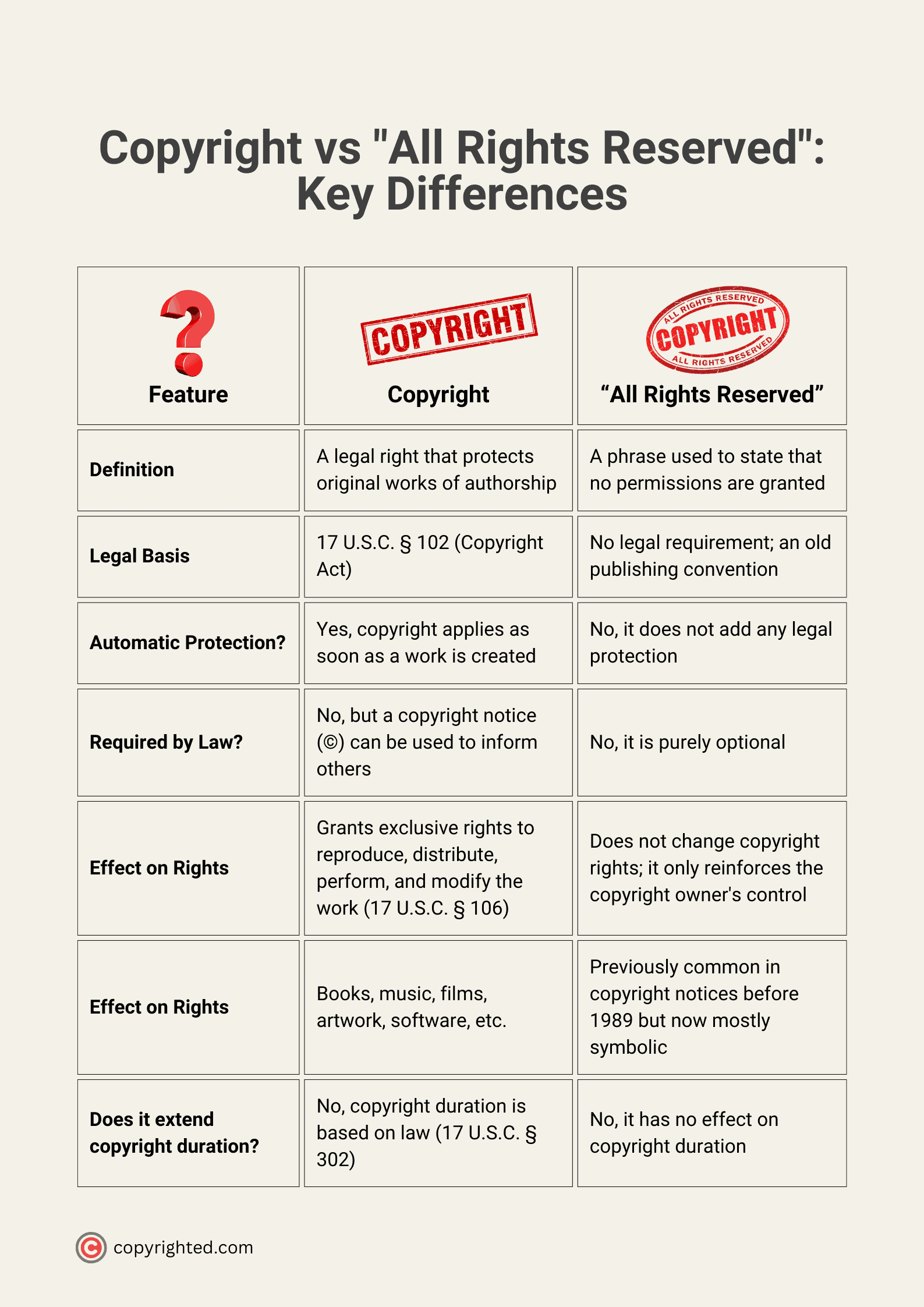You’ve likely seen the phrase “All Rights Reserved” in books, movies, and other creative works. But what does it really mean?
Many assume it’s just another term for copyright, but that’s not entirely correct. This misunderstanding can cause confusion about ownership, usage rights, and legal significance.
If you’re a creator, you may wonder if adding “All Rights Reserved” is necessary or if copyright alone covers your work. If you’re a user, you might be unsure whether you can share or modify content with this label.
This article explains the difference between copyright and “All Rights Reserved” in simple terms. By the end, you’ll know what each term means, how they apply to creative works, and what rights they actually protect.
- Copyright protection is automatic upon creation and does not require writing a copyright notice or the phrase “All Rights Reserved” for validity.
- “All Rights Reserved” is an outdated publishing convention that does not provide additional legal protection but is sometimes used by copyright holders to emphasize ownership.
- Creators can use alternatives like Creative Commons licenses or public domain dedications to clearly define how others may use their work.
Table of Contents
What is the Difference Between Copyright and “All Rights Reserved?”
Copyright and “All Rights Reserved” are related but not the same.
Copyright is a legal protection granted to creators of original works, such as books, music, films, and artwork. It gives the creator exclusive rights to a work to use, distribute, and reproduce their work.
According to 17 U.S.C. § 102 of the U.S. Copyright Act is automatically granted upon creation and fixation of the work in a tangible form.
On the other hand, “All Rights Reserved” is a phrase used by copyright owners to state that they reserve all of the rights associated with the work and are not granting permission for others to use it.
While protected by copyright law, this phrase is often used to emphasize that no rights are waived.
Here is a table summarizing the differences:

How Copyright Works Without “All Rights Reserved”
Copyright protection is automatic. This means a work is protected the moment it is created and fixed in a tangible form, such as being written, recorded, or saved digitally.
There is no requirement for copyright registration in the US Copyright Office or include a notice of copyright for protection to apply, though registration is recommended for legal enforcement.
Because copyright law already grants exclusive rights to the creator, “All Rights Reserved” does not change or strengthen those rights. The copyright holder retains all rights over reproduction, distribution, public display, and adaptations of their work.
Even without this phrase and the copyright symbol, unauthorized use still constitutes an infringement of copyright.
Despite not being legally required, “All Rights Reserved” is sometimes included in copyright notices.
Historically, it was used under international agreements like the Buenos Aires Convention to assert copyright in foreign countries, but this is no longer necessary under a modern copyright treaty like the Berne Convention.
Today, its use is more of a cautionary statement rather than a legal necessity.
Does “All Rights Reserved” Provide Extra Copyright Protection?
No, “All Rights Reserved” does not provide extra copyright protection.
Copyright protection is already granted as soon as a work is created and fixed in a tangible form. The phrase “All Rights Reserved” does not add any legal rights beyond what copyright law already provides.
Historically, this phrase was used under older international copyright agreements, such as the Buenos Aires Convention, to indicate that the creator was not waiving any rights.
However, since the adoption of the Berne Convention, which the U.S. joined in 1989, copyright protection is automatic worldwide, making “All Rights Reserved” unnecessary.
While the phrase does not enhance copyright protection, it is still used by some creators to reinforce that they are not granting any permissions for use. However, legally, it does not change the rights already established by copyright law.
Examples of Copyright and Rights Statements
Different rights statements indicate how a work can be used. Below are real-world examples of common copyright and rights notices:
1. Copyright with “All Rights Reserved”
This statement asserts full copyright control and does not grant any permissions for use. While unnecessary, it is often included for emphasis.
Example:
Copyright © 2025 John Doe. All Rights Reserved.
This means that the creator retains all rights to reproduction, distribution, adaptation, and public display, and no one else may use the work without permission.
2. Creative Commons License Statements
Creative Commons (CC) licenses allow creators to grant specific usage rights while still maintaining copyright ownership. These licenses range from highly permissive to more restrictive terms.
Example (Attribution License – CC BY 4.0):
This work is licensed under a Creative Commons Attribution 4.0 International License.
This means others can share, adapt, and use the work as long as they give proper credit to the creator.
Other CC licenses include:
- CC BY-SA (Attribution-ShareAlike): Requires credit and sharing under the same license.
- CC BY-NC (Attribution-NonCommercial): Allows use but not for commercial purposes.
- CC BY-ND (Attribution-NoDerivatives): Allows sharing but not modifications.
3. Public Domain Dedications
A public domain statement means the creator has waived all copyright rights, making the work free for anyone to use without restrictions. Under 17 U.S.C. § 105, works created by the U.S. government are automatically in the public domain.
Example (Creative Commons CC0 Dedication):
This work has been dedicated to the public domain under the CC0 1.0 Universal Public Domain Dedication.
This means anyone can copy, modify, distribute, and perform the work without permission or attribution.
Frequently Asked Questions
Is “All Rights Reserved” still necessary under copyright law?
No, it is not required since copyright protection is automatic upon creation under modern copyright laws.
Can you use “All Rights Reserved” to protect your work?
While you can include it, it does not add any extra legal protection beyond what copyright already provides.
How can you ensure your work is protected without using “All Rights Reserved”?
Your work is automatically protected under copyright law, but registering it provides additional legal benefits, such as the ability to sue for damages.
What are some alternatives to “All Rights Reserved”?
Alternatives include Creative Commons licenses, which allow you to specify permitted uses, or a public domain dedication if you want to waive rights.
Do you need to register your copyright if you use “All Rights Reserved”?
No, registration is separate from using the phrase. While not required for protection, it strengthens enforcement in legal disputes if someone infringes upon your work.


